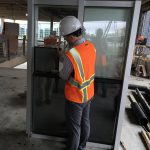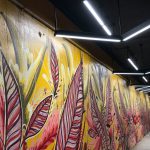Engineering Manufacturing Facilities: With Frank Scalise
You have been working on manufacturing projects for 20 years. How did you first get into engineering manufacturing facilities?
I first got into it working as a draftsman with Ray Alvine on BD [Becton Dickinson] projects in the 1980s. I developed an interest in it from there. It was just so different from anything else Alvine [Engineering] was doing at that time. I also did work for a pharmaceuticals company in Lincoln that involved process engineering, which is very similar and often also a part of manufacturing projects.
What keeps you interested in engineering systems for manufacturing facilities?
I like the variety of designs that come with a manufacturing project, such as processing cooling systems and special filtration systems for manufacturing processes. I also appreciate the opportunity to manage multidisciplinary teams. Alvine is often the lead on BD projects, so we are managing and collaborating with architectural and special system consultants. The technical detail needed also keeps me interested.
“In the end, I get to see a lot of the final products from my systems designs. I get to say ‘I worked on that project,’ which is very satisfying.”

What special challenges make engineering manufacturing facilities different than, say, schools?
There are many! The technical details must be precise because we have a limited space to incorporate all the necessary equipment. For one of the projects we’re currently working on, we need to incorporate all of the process coolant filtration equipment, but were given a very small space to do it. So we’re actually designing it vertically and looking at either raising the roof or lowering the floor to fit it all!
Another challenge is that we’re usually working in a facility that operates 24/7. This requires a lot of phasing throughout the project as one department is mobilized so that construction can take place, and then is moved back. Most of the time, we’re also dealing with very aggressive schedules and down time is critical.
In some of your past projects, you have had to engineer systems for cutting edge equipment that has not even been built yet. How do you design systems for something that does not exist?
We have to make some assumptions. The way we do that is by working with the owner to know what a facility process engineer is going to need to do – we have to put ourselves in their shoes. It doesn’t always work out, sometimes we have to go back and make tweaks or the products don’t work perfectly even after we’ve designed all the systems. But it’s research and development, so that’s just part of the business.
But I would think your long-standing relationship would help with making assumptions, right?
Oh, yes! This relationship has taken years to build, but we work very well together as a team with the client. At this point, I consider myself an extension of the BD team!
You have worked on over 350 projects with Becton Dickinson who manufactures medical equipment, including, most recently, equipment used in the fight against COVID-19. As an engineer, how does your work make you feel like you are making a real difference in the world?
It’s very satisfying, especially, as you said, helping in the fight against COVID-19. We’re making an impact and saving lives. BD produces a lot of diabetes care products, so diabetics get quality products. Saline, also manufactured by BD, helps clean wounds during surgery, and goes all over the world. You might recognize it when it’s used to flush out a tube to sanitize it before you give blood. Our big project right now is upgrading a BD facility so that they can manufacture products to combat the COVID-19 virus.
In the end, I get to see a lot of the final products from my systems designs. I get to say “I worked on that project,” which is very satisfying.
“I appreciate the opportunity to manage multidisciplinary teams. Alvine is often the lead on BD projects, so we are managing and collaborating with architectural and special system consultants.”

Frank Scalise is a mechanical designer with 27 years of professional experience, all with Alvine Engineering. His attention to detail, organizational abilities, and ability to coordinate the work efforts of multiple team members are all instrumental to his success. Frank’s dedication to client relationships is exceptional, having completed over 350 individual projects of varying size and scope for Becton Dickinson’s four campus locations in Nebraska since the early 2000s.



